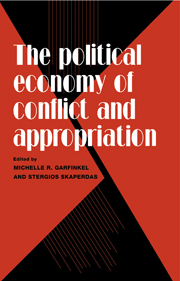Book contents
- Frontmatter
- Contents
- List of contributors
- Acknowledgments
- 1 Introduction: Conflict and appropriation as economic activities
- 2 Anarchy and its breakdown
- 3 Towards a model of territorial expansion and the limits of empire
- 4 Predation and production
- 5 Competitive trade with conflict
- 6 Increasing returns to politics in developing countries with endogenous protection in a fixed-factor model
- 7 Demosclerosis, or special interests “R” us: An information rationale for political gridlock
- 8 Deforestation, investment, and political stability
- 9 Violence and the assignment of property rights on two Brazilian frontiers
- Index
5 - Competitive trade with conflict
Published online by Cambridge University Press: 30 December 2009
- Frontmatter
- Contents
- List of contributors
- Acknowledgments
- 1 Introduction: Conflict and appropriation as economic activities
- 2 Anarchy and its breakdown
- 3 Towards a model of territorial expansion and the limits of empire
- 4 Predation and production
- 5 Competitive trade with conflict
- 6 Increasing returns to politics in developing countries with endogenous protection in a fixed-factor model
- 7 Demosclerosis, or special interests “R” us: An information rationale for political gridlock
- 8 Deforestation, investment, and political stability
- 9 Violence and the assignment of property rights on two Brazilian frontiers
- Index
Summary
Introduction
“If no Naval Force, no Trade,” a British official commented in the eighteenth century. Such an assessment is hardly unique to the beginnings of the British trading empire. Historically, trade, arming, and conflict have always gone hand in hand. The experience of all other European colonial powers can attest to that: the Spaniards, the Dutch, the French, the Russians. Earlier on, Venice and Genoa had similarly created their own trading empires, mostly within the Mediterranean, with the necessary help of strong navies. The Vikings who founded Kievan Russia in the ninth century were both traders and formidable warriors. Similarly, the expansion of Islam in its first century was spearheaded by merchant-warriors.
How does trading affect arming? How do arming and conflict affect trading and the welfare of the interested parties? Such questions cannot be answered with the help of extant models of trade since, by construction, arming and conflict are ruled out. Therefore to begin thinking systematically about issues of conflict and trade, one needs a conceptual framework from which to start. The issue is not of concern just for historical reasons. Trade with overt conflict is pervasive even today but, probably more importantly, other less overt forms of conflict are in principle similar to overt arming and warfare. Our first aim in this paper is to reconcile, in a general equilibrium economic setting, the simultaneous presence of arming, conflict, and trading and thus provide a framework within which such questions can be asked.
- Type
- Chapter
- Information
- The Political Economy of Conflict and Appropriation , pp. 73 - 96Publisher: Cambridge University PressPrint publication year: 1996
- 19
- Cited by



